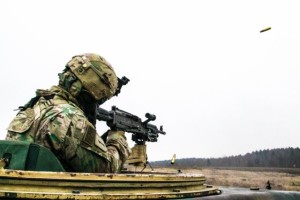The Pentagon has detailed plans to officially pull nearly 12,000 U.S. troops out of Germany, likely to begin within weeks, with officials estimating the move will cost several billion dollars.
Senior defense officials on Wednesday announced the repositioning plan, which has drawn criticism from lawmakers on both sides of the aisle, following the president’s decision in June to reduce the troop presence in Germany.

“The repositioning of our forces in Europe constitutes a major strategic and positive shift wholly in line with the [National Defense Strategy] and consistent with the other adjustments the United States has made within NATO and previous times,” Defense Secretary Mark Esper told reporters during a press briefing. “These changes will achieve the core principles of enhancing U.S. and NATO deterrence of Russia, strengthening NATO, reassuring allies and improving U.S. strategic flexibility and EUCOM operational flexibility.”
The move will draw down troop levels in Germany from 36,000 to 24,000 personnel. Of the 11,900 troops being moved, around 5,600 will be repositioned within other NATO countries while the remaining 6,400 will return to the U.S.
“In terms of cost, it’s going to be a range of things. It’ll be [Operations & Maintenance], it’ll be MILCON, you know, it’ll be the PCS transfers. But of course, you know, you have some gains too, if you’re not moving families back and forth to Germany, you have savings on that end,” Esper said after estimating the cost would be around single-digit billions of dollars.
Lawmakers have previously expressed concerns over the withdrawal plans, with the House including provisions in both its FY ‘21 defense authorization and spending bills seeking to restrict the movement of troops out of Germany (Defense Daily, July 2).
Rep. Mac Thornberry (R-Texas), ranking member of the House Armed Services Committee (HASC), said during his panel’s debate over its NDAA that he was “very concerned by the proposals that were floated” and the potential that “we couldn’t do exercises and we also couldn’t use Germany as a transit point for going to other theaters.”
Rep. Adam Smith (D-Wash.), the HASC chairman, released a statement following the Pentagon’s announcement stating his concerns for the move’s impact on U.S. global operations and that “it will almost certainly result in significant costs to the department.”
“I am very concerned that the Administration’s plan to reduce our forward presence in the EUCOM area of responsibility seems to be based on an arbitrary cap imposed on numbers of forward stationed U.S. forces in a given country, rather than an underlying analysis of military need and national security justification,” Smith said.
Esper was asked about the president’s comments that Germany was “being delinquent” in meeting its NATO burden sharing requirements, and if that factored into the repositioning plan.
“I’m telling you that this is going to accomplish what the president said with regard to getting us down to a lower numbers in Europe, and it meets those other objectives I outlined with regard to the strategic piece, the principles, assuring the allies, and taking care of our service members and families,” Esper said. “Let’s be clear, I think Germany is the wealthiest country in Europe. Germany can and should pay more to its defense. It should certainly meet the 2 percent standard and, I would argue, go above and beyond that.”
Air Force Gen. Tod Wolters, head of European Command (EUCOM), noted the plan includes moving EUCOM headquarters from Stuttgart, Germany to Mons, Belgium, where it will be co-located with Supreme Headquarters Allied Powers Europe (SHAPE) headquarters.
Wolters also said there’s a potential plan to also shift Africa Command headquarters, also currently located in Stuttgart, out of Germany.
Esper noted the move also includes repositioning an F-16 fighter squadron and elements of a fighter wing from Germany to Italy.